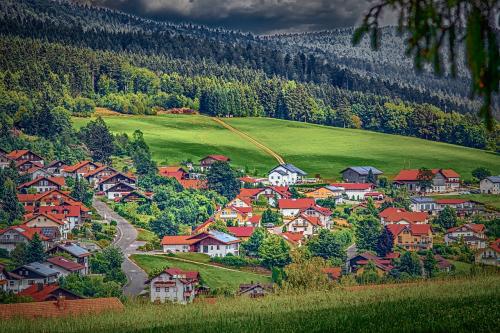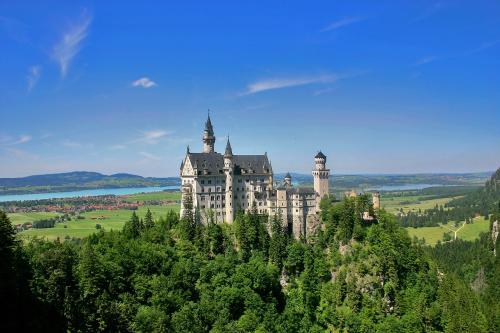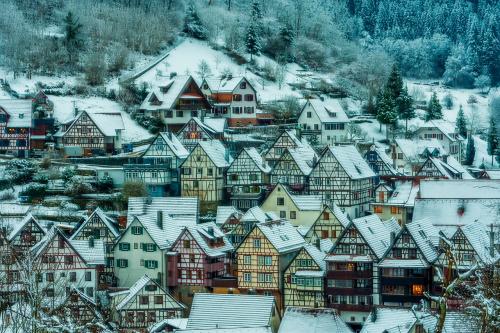Best Time to Visit Germany

Northern third of the country is plain with sets of low gentle hills. It is washed by the North Sea in west and by the Baltic Sea in east. Central region lies on foothills of the Alps while southern portion is mountainous. Mentioned features of relief affect climate of respective regions.
The country is situated in the zone of temperate climate with some features of maritime weather conditions on northern coasts and transition to continental in mountains. Global location, relief and hydrography of Germany are resulting shifty weather. Any given bright summer day may be followed by week or so of cool and rainy weather. And at the same time natural disasters (i.e. drought, tornadoes, floods or extreme temperatures) are very rare.
Average temperature of July, the warmest month, is ranging from 14 °C (57 °F) in mountains to 22 °C (71 °F) in plains. In January air cools down to 4 °C (39 °F) in flat lands while people of mountainous regions are dealing with -5 °C (23 °F). Inland plain regions receive the least precipitation while northern coasts and Central German Uplands are rainier. Southern highlands are naturally the rainiest regions due to altitude-related distribution of precipitation.
Season and Low Season
Contents:
Season in Germany
Modern culture, historical heritage and marvelous nature attract millions of tourists each year. In general tourist season lasts through while year, but, there are some busy and quiet periods. Ski resorts in the Bavarian Alps are crowded between December and early March while main cities have burst of tourist interest during Christmas celebrations.
In July and August people head to Germany for excursion. And in October Munich turns to the world center of beer for two weeks. Massive celebrations of Oktoberfest attract up to 7 million visitors to the capital of Bavaria each year.
Summer weather is perfect for outdoor and indoor activities. Daytime temperature sits around 22 °C (71 °F) and in eastern regions even reaches 30 °C (86 °F) from time to time. In mountains air warms up to 12-15 °C (53-59 °F) depending on location and altitude of given locality. Also, summer is the rainiest season. There is up to 55 mm (2.1”) of monthly precipitation. Rain falls as short showers creating no inconvenience.
In winter temperature in plain part of the country sits above freezing most of the time. Due to altitude it is colder in Alps with average temperatures of -4 °C (25 °F) to -10 °C (14 °F). Highlands receive precipitation in form of snow while in flatland it is rain or sleet.
Low Season in Germany
Lowest influx of tourists to the country is observed in early spring, late autumn and in two weeks before Christmas. And even during those periods of transitional weather with long drizzly rains and nasty temperature ranges Germany is open for tourists. Spectacular local culinary and products of brewing are available year round.
Considering given above there is no actual low season in Germany. As other European countries, Germany offers entertainment in any season and preferable time to journey depends only on desired type of activities. Winter is better for skiing while summer is great for getting familiar with the country.
Climate and Seasonality by Month
(Berlin)
| Jan | Feb | Mar | Apr | May | Jun |
| ❄ | ❄ | ⛅ | ⛅ | ⛅ | ⛅ |
| -1°C 30°F |
0°C 32°F |
4°C 39°F |
9°C 48°F |
14°C 56°F |
17°C 62°F |
| 1.8" | 1.6" | 1.6" | 1.8" | 2.2" | 2.7" |
| ⛷ | ⛷ | ⛷ | ⌘ | ⌘ | ⌘ |
| Jul | Aug | Sep | Oct | Nov | Dec |
| ⛅ | ⛅ | ⛅ | ⛅ | ⛅ | ❄ |
| 19°C 66°F |
18°C 64°F |
14°C 58°F |
10°C 51°F |
4°C 40°F |
1°C 34°F |
| 2.2" | 2.5" | 1.8" | 1.6" | 2.0" | 2.2" |
| ⌘ | ⌘ | ⌘ | ⌘ | ⛷ | ⛷ |
❄ - cold; ⛅ - comfort; ☔ - wet
t° - average; inch - precipitation
⛷ - ski; ⌘ - excursion
 Seasons of the Year
Seasons of the Year 






